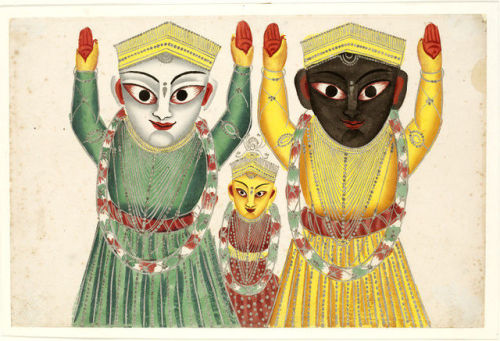#hinduism
beinghindu and homophobic indicates you have little to no understanding of your own people and culture.
some of you STILLaren’t able to comprehend the fact that the south asian subcontinent has been invaded since500CE by mughal and western colonizers with abrahamic ideologies. it has wiped the normalcy, acceptance and appreciation of same-sex relations, gender fluidity, trans identity which is indigeneous to the land, since at a recordeddate of 4000BCE, as observed in dharmic culture.
Jagannatha, Balabhadra and Subhadra - Unknown Indian Artist, ca. 1830
Painted in opaque watercolour and tin on paper, 287 mm, 440 mm
“Jagannatha is worshipped particualry at Puri in Orissa. According to Legend, Krishna was killed by a hunter. His bones were found and vishnu directed a king, Indrayumna, to make an image of Jagannatha and place the bones inside it. The carpenter of the gods, Viswakarma, agreed to make the image is he was left undisturbed. On being interrupted by Indrayumna, Viswakarma lost his temper and refused to finish the image. This is said to explain the crude form taken by the Jagannatha image at Puri, where the body resembles a wooden stump with a large blunt head. In appearance, the three often conform to the simplified images in teh temple, but at times are shown more realistically with developed bodies, hands and feet”. (Archer, 1971, p100)
Calcutta was the capital of British India from 1833-1912. By the 1830s, artists had arrived in Calcutta from rural villages in Bengal and began to produce paintings that reflected the local history, mythology, customs and conflicts of a colonised society. As a popular art form, these artists are recognised for their use of brilliant colour, simplified images and swift brushstrokes that became the hallmark of Kalighat painting in the 19th and early 20th century. [x]
Post link

